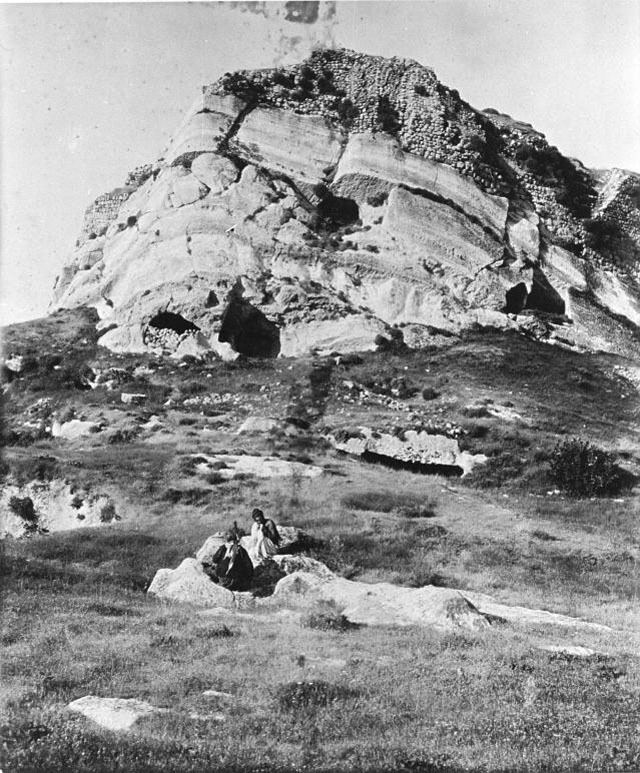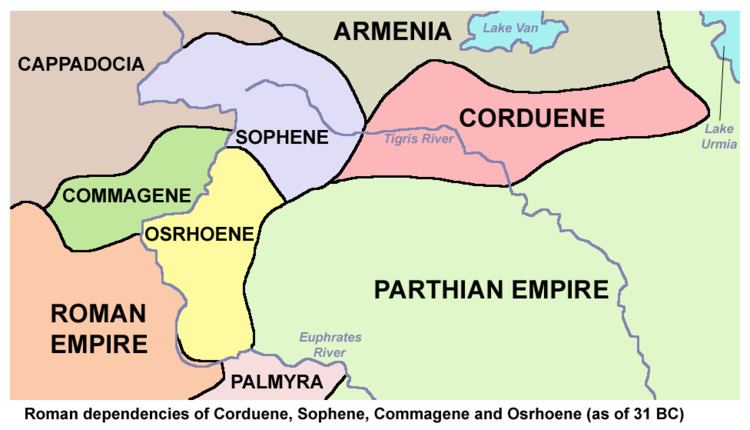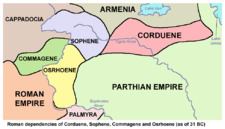 | ||
Corduene brother
Corduene (also known as Gorduene, Cordyene, Cardyene, Carduene, Gordyene, Gordyaea, Korduene, Gordian; Kurdish: Kardox; Turkish: Karduya; Armenian: Կորճայք Korchayk; Greek: Κορδυηνή Kordyene; Hebrew:קרטיגיני ) was an ancient region located in northern Mesopotamia, present-day south-eastern Turkey and northern Iraq.
Contents
- Corduene brother
- Origins
- Carduchoi in Xenophon
- Pompey and Corduene
- Armenian presence
- Diocletian and Corduene
- Shapurs campaign against Corduene
- Corduene in the 6th and 7th centuries
- List of kings
- Corduene Carduchi and the Kurds
- Timeline of the history of Corduene Gordyene
- References

According to the 1911 Encyclopaedia Britannica, Gordyene is the ancient name of the region of Bohtan (now Şırnak Province). It is mentioned as Beth Qardu in Syriac sources and is described as a small vassal state between Armenia and Persia in the mountainous area south of Lake Van in modern Turkey Corduene must also be sought on the left bank of the Tigris.

It has been cited as the country of the Carduchians, a fertile mountainous district, rich in pasturage. The Kingdom of Gordyene emerged from the declining Seleucid Empire and for most of its history, it was a province of the Roman Empire and acknowledged the sovereignty of Rome. From 189 to 90 BC, it enjoyed a period of independence. The people of Gorduene were known to have worshipped the Hurrian sky God Teshub.
Origins
According to Arshak Safrastian, the Medes and Scythians mentioned in classical Greek literature existed only as preconceived notions. Equating the Carduchi with the Gutians, he adds that the moment the Ten Thousand began to skirt the lower slopes of the Hamrin Mountains, they were in contact with the tribes of Gutium which are presented here as Medes or Scythians.
Carduchoi in Xenophon
A people called the Carduchoi are mentioned in Xenophon's Anabasis. They inhabited the mountains north of the Tigris in 401 BC, living in well-provisioned villages. They were enemies to the king of Persia, as were the Greek mercenaries with Xenophon, but their response to thousands of armed and desperate strangers was hostile. They had no heavy troops who could face the battle-hardened hoplites, but they used longbows and slings effectively, and for the Greeks the "seven days spent in traversing the country of the Carduchians had been one long continuous battle, which had cost them more suffering than the whole of their troubles at the hands of the king [of Persia] and Tissaphernes put together."
They have been also mentioned as Gordi by Hecataeus of Miletus c. 520 BC.
Pompey and Corduene
Both Phraates III and Tigranes the Great laid claim to this province. However, it was conquered by the Roman troops under Pompey. The local population (called Gordyeni) did not defend the Armenian rule since according to Plutarch, Tigranes had demolished their native cities and had forced them into exile in Tigranocerta. In 69 BC, Zarbienus, the king of Corduene, was secretly planning for a revolt against Tigranes. He was negotiating with Appius Claudius for Roman help. However the plan was revealed and he was killed by Tigranes. After this, Lucullus raised a monument to Zarbienus and then he took over the region of Corduene. He took part in the funeral of Zarbienus, offered royal robes, gold and the spoils (taken from Tigranes), and called him his companion and confederate of the Romans.
After Pompey's success in subjugating Armenia and part of Pontus, and the Roman advance across the Euphrates, Phraates was anxious to have a truce with the Romans. However, Pompey held him in contempt and demanded back the territory of Corduene. He sent envoys, but after receiving no answer, he sent Afranius into the territory and occupied it without a battle. The Parthians who were found in possession were driven beyond the frontier and pursued even as far as Arbela in Adiabene. According to an inscription dedicated to the temple of Venus, Pompey gave protection to the newly acquired territory of Gordyene.
Armenian presence
Tigran retained Gordyene and Nisibis, which Pompeius withheld from the Parthians. Gordyene belonged to Urartu for about 200 years and to Armenia for about 250 years.
Districts of Cordyene under Armenian period were:
Korduq (or Korduk), Kordiq Nerkin, Kordiq Verin, Kordiq Mijin, Tshauk, Aitvanq, Vorsirank (or Orsirank), Aigarq, Motolanq, Kartuniq, Albag.Diocletian and Corduene
Corduene was conquered again by Diocletian in the 3rd century and the Roman presence in the region was formally recognized in a peace treaty signed between Diocletian and the Persians. Diocletian then raised an army unit from this region under the title Ala XV Flavia Carduenorum, naming it after his Caesar Flavius Valerius Constantinus.
Following the defeat of Narseh, the Sassanid King, at the hands of the Romans in 296, a peace treaty was signed between the two sides, according to which the steppes of northern Mesopotamia, with Singara and the hill country on the left bank of the Tigris as far as Gordyene (Corduene), were also ceded to the victors (Romans).
The name of the province appears again in the account of the campaign between the Persians led by Shapur II and the Romans led by Julian the Apostate (and after Julian's death, by Jovian). The Romans started to retreat through Corduene after they could not besiege Ctesiphon.
Shapur's campaign against Corduene
In the spring of 360, Shapur II staged a campaign to capture the city of Singara (probably modern Shingar or Sinjar northwest of Mosul). The town fell after a few days of siege. From Singara, Shapur directed his march almost due northwards, and leaving Nisibis unassailed upon his left, proceeded to attack the strong fort known indifferently as Pinaca (Phaenicha) or Bezabde. This was a position on the east bank of the Tigris, near the point where that river quits the mountains and debouches upon the plain; though not on the site, it may be considered the representative of the modern Jezireh (Cizre in southeastern Turkey), which commands the passes from the low country into the Kurdish mountains. It was much valued by Rome, was fortified in places with a double wall, and was guarded by three legions and a large body of Kurdish archers. Shapur sent a flag of truce to demand a surrender, joining with the messengers some prisoners of high rank taken at Singara, lest the enemy should open fire upon his envoys. The device was successful; but the garrison proved staunch, and determined on resisting to the last. After a long siege, the wall was at last breached, the city taken, and its defenders indiscriminately massacred.
In 363, a treaty was signed in which Jovian ceded five provinces beyond the Euphrates including Corduene and Arzanene and towns of Nisibis and Singara to the Sassanids. Following this treaty, Greeks living in those lands emigrated due to persecution of Christians at the hands of Shapur and the Zoroastrians.
Corduene was a bishop's see since at least 424.
Corduene in the 6th and 7th centuries
In 578, the Byzantine emperor Flavius Mauricius Tiberius Augustus defeated the Sassanid army led by Chosroes I, and conquered Corduene and incorporated it once again in the Roman empire. The Roman army also liberated 10,000 Christian captives of the Sassanids. According to Khwarizmi, Arabs conquered the area along with Nisbis and Tur Abdin in 640.
List of kings
Corduene, Carduchi, and the Kurds
19th-century scholars, such as George Rawlinson, identified Corduene and Carduchi with the modern Kurds, considering that Carduchi was the ancient lexical equivalent of "Kurdistan". This view is supported by some recent academic sources which have considered Corduene as proto-Kurdish or as equivalent to modern-day Kurdistan.
There were numerous forms of this name, partly due to the difficulty of representing kh in Latin. The spelling Karduchoi is itself probably borrowed from Armenian, since the termination -choi represents the Armenian language plural suffix -kh. It is speculated that Carduchi spoke an Old Iranian language.
Jewish sources trace origins of people of Corduene to marriage of Jinns of King Solomon with 500 beautiful Jewish women. The same legend was also used by the early Islamic authorities to explain origins of Kurds.
